Land grading might not be the first thing that comes to mind when envisioning backyard improvements, yet it plays a foundational role in ensuring the longevity and beauty of your outdoor space. Much like the understated importance of a well-prepared canvas to a masterpiece, proper land grading sets the stage for a backyard that is not only visually appealing but also functional and resilient. This critical process distinguishes itself by offering a solution to potential water damage, creating an efficient water runoff system, and providing a stable base for landscaping or construction projects.
Essential techniques in land grading include managing the slope to direct water away from your home and ensuring even, compacted soil for future projects. Each aspect of land grading—from choosing the right tools and equipment to addressing common challenges—brings its own set of considerations, methods, and benefits. The following sections will delve into these topics, offering a comprehensive guide to mastering land grading in your backyard.
This exploration will equip homeowners with the knowledge to either tackle land grading independently or make informed decisions when hiring professionals, ultimately enhancing the enjoyment and value of their outdoor living space.
Why is proper land grading important?

Proper land grading is crucial for protecting your home and enhancing your backyard’s usability. It serves as a preventive measure against water damage to foundations and basements by ensuring water flows away from structures rather than accumulating. This process also guarantees efficient soil drainage, reducing the risk of waterlogging and promoting healthier plant growth.
Furthermore, it creates a stable and level base for any landscaping or hardscaping projects, preventing future issues like uneven settling or erosion. By prioritizing proper land grading, homeowners can safeguard their property and lay the groundwork for a beautiful and functional outdoor space.
Prevents water damage to foundations and basements
Proper land grading diverts water away from your home, preventing it from pooling around foundations and basements. This protection is key to avoiding costly repairs and structural damage caused by water infiltration.
Ensures efficient water runoff and soil drainage
By creating a gentle slope away from your home, land grading facilitates efficient water runoff. This ensures that soil remains well-drained, reducing waterlogging and promoting healthier plant and lawn growth.
Creates a stable base for landscaping and hardscaping
A well-graded land provides a level and firm foundation for any landscaping or hardscaping projects. This stability is essential for preventing uneven settling or erosion, ensuring that your outdoor space remains beautiful and functional for years to come.
How to plan your land grading project
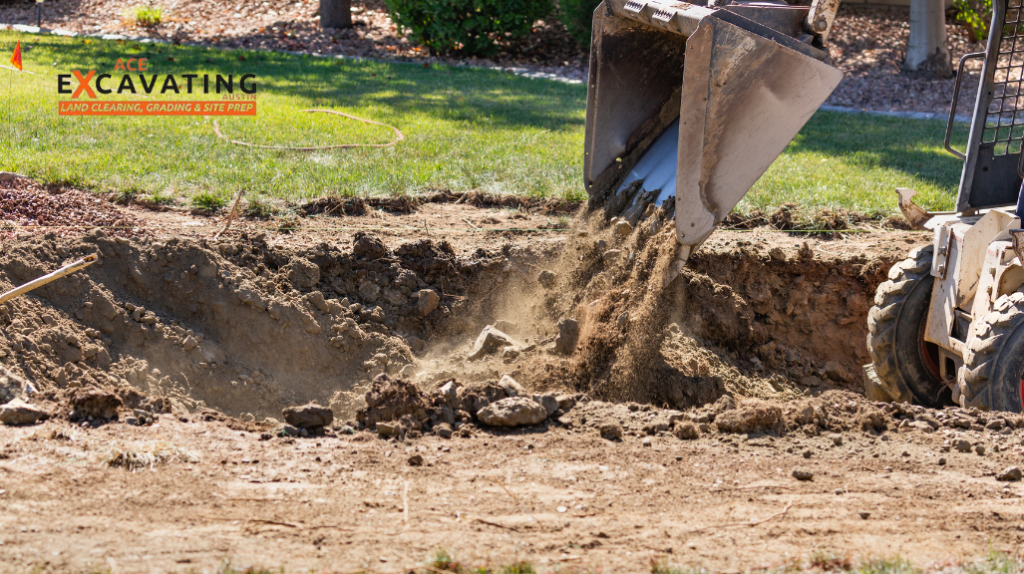
Planning your land grading project begins with assessing the natural slope of your backyard using tools like a level or transit. This initial step helps identify how water currently moves across the area, which is crucial for directing future runoff. Observing drainage patterns during rainfall or by simulating it with a water hose can pinpoint areas prone to waterlogging or erosion.
Determining the desired slope—typically 1-2% away from your home and other structures—ensures efficient water drainage while maintaining the integrity of your property. This careful planning lays the groundwork for a successful land grading process, ultimately enhancing the functionality and aesthetics of your outdoor space.
Assess the natural slope with a level or transit
To kickstart your land grading project, assess the natural slope of your land using a level or transit. This crucial first step helps you understand the existing gradient and how water moves across your property, setting the stage for effective grading.
Identify drainage patterns using water hose or during rainfall
Identifying drainage patterns is essential for a successful land grading plan. Simulate rainfall with a water hose or observe natural rainfall to see how water flows and pools in your backyard. This insight allows you to pinpoint areas that need attention to ensure proper water runoff.
Find Out More: How Much Does Land Grading Cost
Determine the desired slope: 1-2% away from structures
For optimal water drainage, determine the desired slope of your land, aiming for a 1-2% gradient away from your home and other structures. This slight incline is key to directing water efficiently, preventing accumulation near foundations, and maintaining the health of your landscape.
Choosing the right tools and equipment
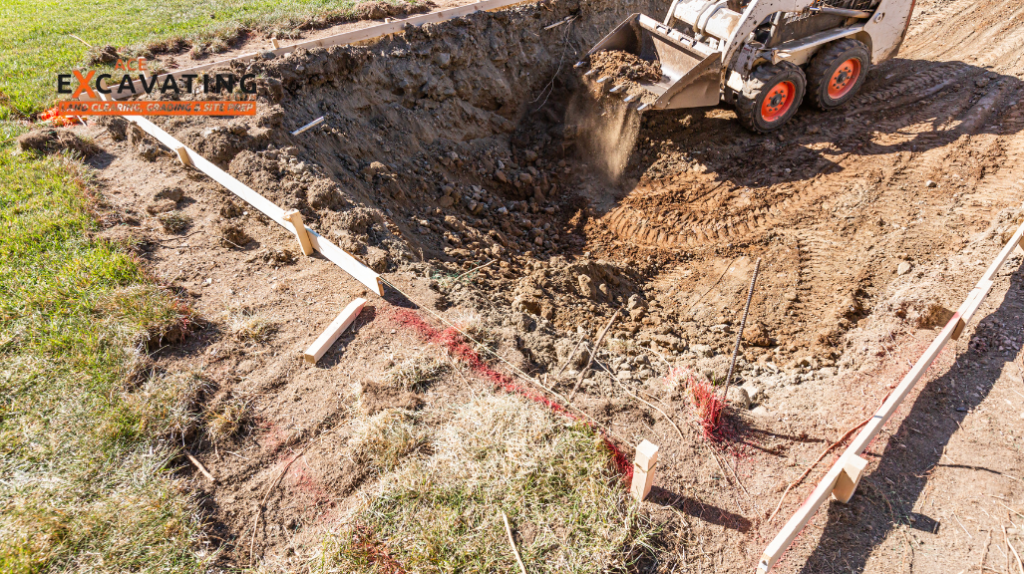
Selecting the appropriate tools and equipment is a pivotal step in executing a successful land grading project. For smaller areas, manual tools like spades and landscaping rakes are sufficient and offer precision. However, larger projects demand power tools such as skid steer loaders, which provide the necessary force and efficiency.
Additionally, employing laser levels can ensure accuracy in maintaining the desired slope across the land. This careful choice of tools not only streamlines the grading process but also contributes to achieving a well-drained, aesthetically pleasing, and functional outdoor space.
Manual tools: spades, landscaping rakes for small areas
For smaller grading tasks, manual tools such as spades and landscaping rakes are ideal. They allow for detailed work and precise control over the soil, making them perfect for minor adjustments and small-scale projects.
Power tools: skid steer loaders, laser levels for accuracy
For larger land grading projects, power tools like skid steer loaders become indispensable due to their efficiency and capability to move large amounts of soil quickly. Laser levels are also crucial in these scenarios, providing the accuracy needed to ensure the land is graded correctly according to the planned slope.
| Tool Type | Specific Tool | Best For | Tips/Notes |
| Manual | Spade | Digging and precise soil movement | Choose one with a comfortable grip and durable material. |
| Manual | Landscaping Rake | Smoothing and leveling soil | A rake with a wide head can cover more area efficiently. |
| Power | Skid Steer Loader | Moving large volumes of soil | Ensure proper training for safe operation. Ideal for extensive land grading projects. |
| Power | Laser Level | Ensuring accurate and consistent slope | Use for setting precise gradients over large areas. Essential for projects requiring exact slope measurements. |
Tips for effective land grading
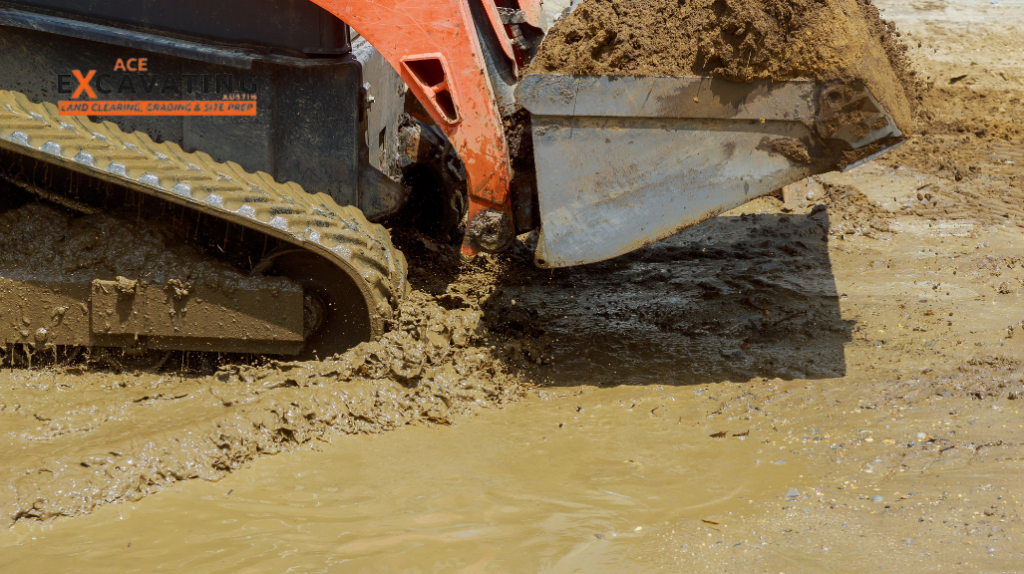
Effective land grading is achieved by starting from the highest point of your land to control the direction of runoff effectively. Ensuring that you grade away from your house for at least 5 feet is crucial to prevent water damage. Using stakes and strings can help maintain a consistent slope across the area, which is vital for efficient water drainage and soil stability.
Additionally, compacting the soil with a roller or tamper after grading helps to solidify the base, making it more resilient to erosion and settling. These tips, when followed meticulously, can significantly enhance the success of your land grading project, leading to a more functional and visually appealing outdoor space.
Start from the highest point to control runoff direction
To effectively control the direction of water runoff, begin the grading process from the highest point on your property. This strategic approach ensures that water flows away from structures, thereby preventing potential damage. Identify the highest point by using a level or transit.
Mark this point and plan your grading efforts to slope downward from here, ensuring water is directed away from your home and other structures.
Grade away from your house at least 5 feet
It’s crucial to grade the land so that it slopes away from your house for at least 5 feet. This safety margin is essential for minimizing the risk of water damage to your home’s foundation and basement areas. Use a tape measure to mark a distance of 5 feet from your home’s foundation.
Place stakes at this distance around the perimeter of your house, and use them as a guide to ensure the slope extends at least this far.
Use stakes and strings for consistent slope maintenance
Employing stakes and strings across the grading site helps maintain a consistent slope. Drive stakes into the ground at the corners of your grading area and at key points along the slope. Tie strings between these stakes at the desired slope level, using a level to ensure accuracy.
This setup acts as a visual guide to keep the slope uniform across the entire area, facilitating proper drainage and a balanced landscape.
Compact the soil with a roller or tamper for stability
After grading, compacting the soil with a roller or tamper is essential for ensuring stability. For smaller areas, a hand tamper is sufficient to compact the soil and eliminate air pockets. In larger areas, a lawn roller filled with water or sand provides the necessary weight for effective compaction.
Choose the appropriate tool based on the size of your graded area and the type of soil. Sandy soils may require less compaction than clay-heavy soils, which can become very dense and may need more effort to compact properly.
Addressing common challenges in land grading
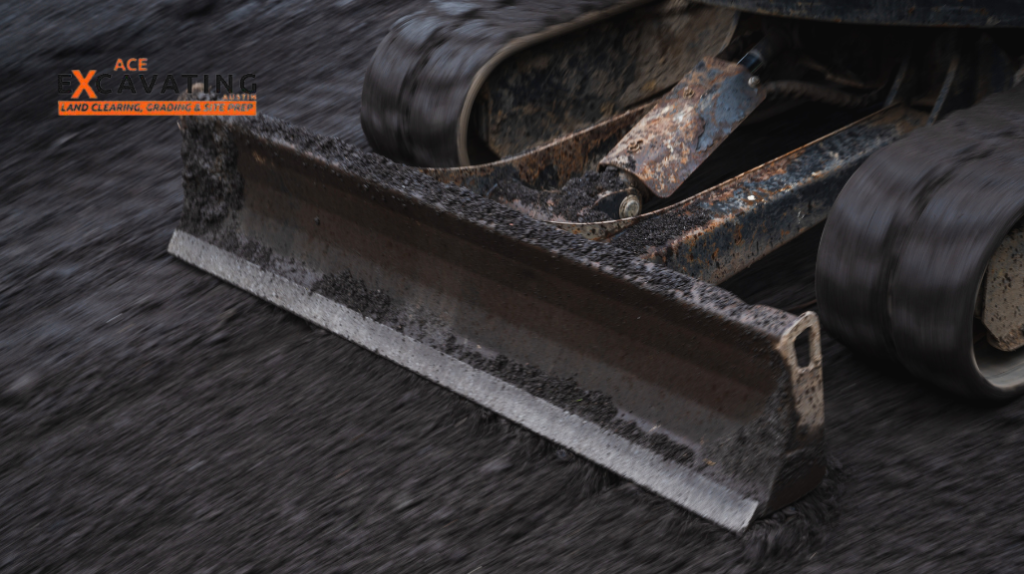
Land grading often presents a set of challenges that require strategic solutions. Dealing with rocky soil may involve using pickaxes or machinery to break up the ground, making it more manageable for grading. For large areas, implementing a grid system can help manage the project systematically, ensuring that each section is graded with consistency and accuracy.
Additionally, flexibility in planning is crucial when encountering underground utilities or tree roots; adjustments may need to be made to the grading plan to accommodate these obstacles. By anticipating and addressing these common challenges, homeowners and professionals can ensure a smoother grading process, resulting in a well-prepared and functional outdoor space.
Removing or breaking up rocky soil with pickaxes or machinery
When faced with rocky soil, employing pickaxes or machinery is effective for breaking up the ground. This approach makes the soil more amenable to grading and ensures a smoother land preparation process. Safety tips include wearing protective gear, such as gloves and eye protection, and ensuring the area is clear of bystanders before beginning work.
For larger rocks or tougher terrain, machinery like a mini excavator may be necessary, and it’s often more efficient to hire professionals for this task.
Using a grid system to manage large areas systematically
For grading large areas, implementing a grid system is a strategic method that ensures systematic management. This technique involves dividing the land into smaller, manageable sections, often marked by stakes and string. Each section can then be graded individually, ensuring consistent and accurate results across the entire project area.
Instructions for setting up a grid system include measuring the area, determining the number of sections based on the total size, and marking each section clearly before beginning the grading process.
Flexibility in plans for underground utilities or tree roots
Encountering underground utilities or tree roots requires flexibility in your grading plans. Before starting your project, it’s essential to call a utility locating service to mark any underground lines. If you encounter tree roots, consider rerouting your grading plan to avoid damaging the tree or consult with an arborist for advice on how to proceed without harming the root system.
Strategies for adjusting grading plans include using shallower slopes around sensitive areas or incorporating raised beds or retaining walls to manage soil levels without disturbing roots or utilities.
Maintaining your graded land
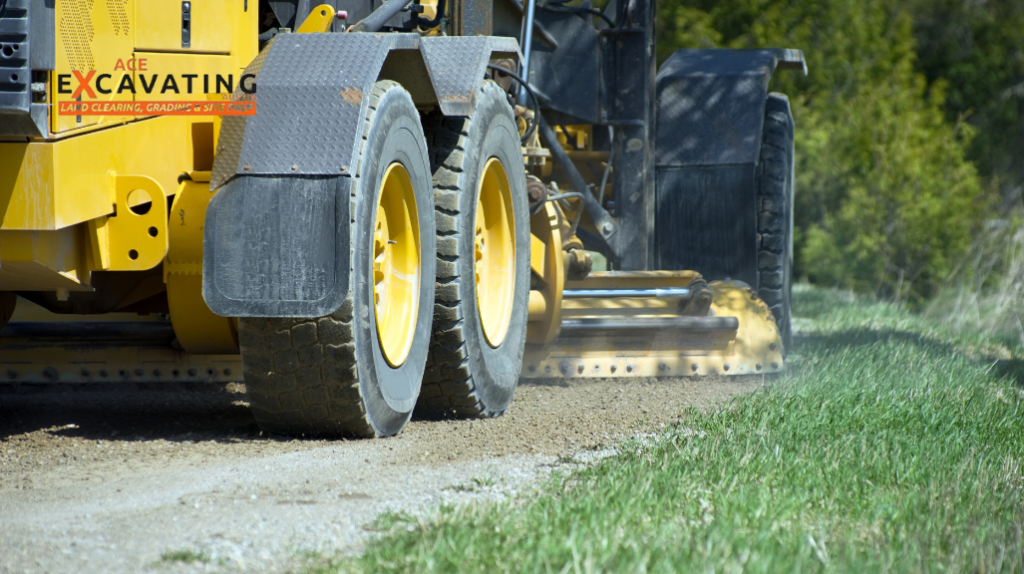
After successfully grading your land, ongoing maintenance is essential to preserve its condition and functionality. Regular inspections, especially after significant rainfall, can help identify and repair any erosion that might compromise the landscape’s integrity. Planting native grasses and shrubs can also play a crucial role in preventing soil erosion, as their roots help to bind the soil, providing additional stability.
Furthermore, installing drainage solutions like French drains or catch basins can enhance the land’s drainage efficiency, ensuring that water continues to flow away from structures and into designated areas. By adhering to these maintenance practices, homeowners can ensure their graded land remains healthy, stable, and attractive for years to come.
Inspect and repair erosion after significant rainfall
Conducting regular inspections, particularly after heavy rain, is key to identifying areas where erosion has occurred. Prompt repairs to these areas help maintain the land’s integrity and prevent further damage.
Plant native grasses and shrubs to prevent soil erosion
Incorporating native grasses and shrubs into your landscape is an effective strategy for soil stabilization. Their root systems anchor the soil, significantly reducing the risk of erosion.
| Climate Zone | Grass Types | Shrub Types | Benefits |
| Arid | Buffalo Grass, Blue Grama | Sagebrush, Creosote Bush | Drought-resistant, low water requirement |
| Temperate | Fescue, Kentucky Bluegrass | Dogwood, Spirea | Cool-season growth, versatile |
| Tropical | Bermuda Grass, Zoysia | Hibiscus, Bougainvillea | Heat-tolerant, vigorous growth |
| Wetland | Reed Canary Grass, Wild Rice | Willow, Red Osier Dogwood | Water-tolerant, stabilizes wet soil |
Install French drains or catch basins for improved drainage
To optimize water management, consider installing French drains or catch basins. These drainage solutions effectively channel water away from your property, enhancing the overall efficiency of your land’s drainage system.
| Drainage Solution | Best For | Installation Tips |
| French Drains | Areas with prolonged moisture, near foundations | Install at the lowest point of your yard, ensure a slope for proper drainage |
| Catch Basins | Collecting surface water, areas prone to flooding | Place at strategic points where water pools, connect to a storm drain if possible |


Pingback: 6 Essential Tips When Land Grading Your Backyard – Ace Excavating Austin – Land Clearing, Grading & Site Prep